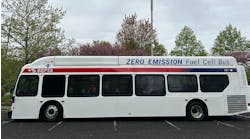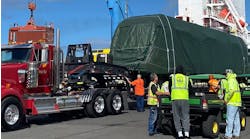Vale and GE Transportation announced an agreement to install GE’s Trip Optimizer, a first-of-its-kind solution on nearly 114 Vale locomotives in operation across Brazil. Trip Optimizer is a smart, automated cruise control system that ingests data, analyzes route topology and conditions, and creates an optimally fuel-efficient plan, producing fuel savings up to 10 percent.
The locomotives will run along the Estrada de Ferro Carajás (EFC) [the Carajás railroad], which connects Vale's mines in the southeast of Pará state to the Ponta de Madeira Maritime Terminal in Maranhão state. Preliminary tests produced fuel savings of up to 2.45 percent, but upon full deployment in 2019, Vale is expected to save 9.4 million liters of B8 diesel and reduce CO2 emissions by 22,700 tons per year.
Trip Optimizer has logged more than 200 million miles in auto control mode, saving GE customers more than 118 million gallons of fuel. The solution, in real time, can determine the appropriate time to accelerate or brake, analyzing factors such as train length, weight, track quality and conditions, - to achieve the greatest fuel efficiency.
"Trip Optimizer enables Vale to increase logistics productivity. Another important aspect is the environmental benefit. It also reduces carbon dioxide emissions by using less fuel," said Humberto Freitas, executive director of logistics and environmental research.
"These are some of the largest trains in the world, comprising 334 wagons and three locomotives. The main locomotive drives and two auxiliaries are placed every 110 wagons.
To meet Vale's needs, we customized Trip Optimizer, in partnership with engineers at our global Research Center in Rio de Janeiro, to better navigate the dynamic characteristics of the Brazilian landscape and maximize fuel savings," said Marcos Costa, president and CEO of GE Transportation in Latin America.
The customized solution can identify track speed limits, which enables the train to operate close to the limit without exceeding it, as well as reduce the risk of braking couplings between the wagons that occur at times of rapid acceleration and deceleration.
"Trip Optimizer starts operating when the vehicle reaches a speed of 19 kph; we’re working to improve this by developing a system that kicks in when the machine starts," said Alexandre Silva, leader of the Smart Systems area at GE's Global Research center in Brazil. “The solution standardizes driving with less internal force on the couplings and increases safety. It is a great example of how GE is leading in the Digital Industrial."
“The locomotives will run on autopilot to achieve the diesel consumption target,” said Leonardo Vieira Machado Alexandre, Manager of Railroad Engineering at Vale. “The early tests on the Carajás Railroad were particularly difficult, because of the size and weight of the train. Over time, GE developed the system in partnership with Vale's engineers to achieve more efficient driving." Pilot tests on the Vitória-Minas Railroad, linking Vale's mines to the Port of Tubarão, and along the Nacala Corridor, in Mozambique, where the company has coal operations, will be started shortly.
Trip Optimizer has been implemented in the United States, Canada, Australia, China, Mexico, and now in Brazil and Mozambique on Vale's railroads. Almost 3,000 trains a day operate using this technology. These locomotives have covered over 16 million kilometers.


